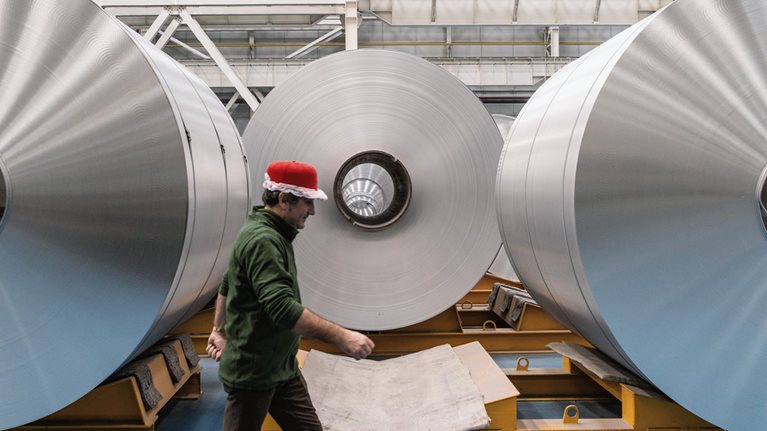The 2020s may mark the beginning of a fundamental shift for corporations: from pure profit maximization to a new approach to growth—one that gives due weight to the health of society and the planet. As organizations embrace this dual mission of profitability and sustainability, efforts to mitigate climate change are at the top of the agenda.
Sustainability has already become an integral part of business decision making: consumers and corporate purchasers increasingly consider carbon footprints when they make buying and investment decisions. That gives companies significant market opportunities to differentiate themselves through low- or zero-carbon offerings.
Discrete manufacturing at the forefront
Today, manufacturers of physical products find themselves on the front lines of sustainability. In part, that’s because their customers demand cleaner, lower-carbon products right now. In the high-tech sector, for example, Apple’s targets for reducing Scope 1 and Scope 2 emissions far exceed the minimum requirements of the Science Based Target Initiative’s (SBTi) 1.5° pathway, and the company is committed to achieving Scope 3 carbon neutrality by 2030. The electric carmaker Polestar has established a “striving for net zero” mission that aims to create a truly climate-neutral car by 2030 through intense collaboration with suppliers, entrepreneurs, and innovators.
Discrete manufacturing organizations are also well positioned to understand, manage, and mitigate their environmental impact, thanks to their progress in digitizing operations and supply chains over the past decade. To recognize manufacturing enterprises that embrace both sustainability and the Fourth Industrial Revolution (4IR) at scale, last year the World Economic Forum (WEF) announced a new category in its Global Lighthouse Network1 program: the Sustainability Lighthouse. These businesses are applying 4IR technologies to reduce their environmental footprint significantly.
This doesn’t mean that decarbonizing discrete manufacturing is easy. To begin with, modern manufacturers have long, complex, geographically diverse, and multitiered value chains. A large proportion of their overall emissions footprint in those value chains is outside the manufacturer’s direct control: the energy required to produce and transport raw materials and components and the energy consumed by products during their working lives (Exhibit 1).

Leading manufacturing organizations are already making big steps to tackle carbon emissions across their value chains. The focus of these efforts varies significantly, depending on the emissions footprint of each organization’s value chain and the relative cost, impact, and accessibility of different emissions reduction levers (Exhibit 2). In addition to the well-established steps (such as switching to alternative energy sources or improving energy efficiency), a much larger variety of emissions-reducing innovations is now available, including low- or zero-carbon raw materials, greener product designs, and improved overall product usage that strengthens the circular economy.

Lessons learned
As organizations in other sectors develop their own sustainability strategies, many could benefit from the hard-won experience of leading discrete manufacturers. Their most successful carbon reduction programs share two characteristics. First, these companies have acted boldly by capturing the maximum potential through changes across their operations. Second, they have moved quickly—for example, by seeking first-mover advantages to secure sources of low-carbon materials or positioning themselves as preferred suppliers of sustainable products.
This willingness to make big, rapid moves is backed up by a systematic approach to carbon reduction. Discrete manufacturing’s sustainability pioneers stand out in four areas.
Would you like to learn more about our Operations Practice?
1. Transformation with a dual mission
Leading organizations embrace the dual mission, which addresses profitability and sustainability together (Exhibit 3). That matters because decarbonization often requires technical changes to product designs, materials specifications, and supply chain footprints. Those changes also provide opportunities to optimize costs—for example, by fine-tuning materials specifications, reducing the complexity of products, or bundling higher-volume orders with suppliers. Therefore, especially for early movers, low-carbon products can create revenue growth opportunities. As a result, companies can access new markets or position their offerings in premium segments because of their superior environmental credentials.

An automotive supplier in Asia, for instance, has used a dual-mission transformation to address its OEM customers’ need to cut supply chain emissions. The company began by establishing baseline emissions at the product level. It then identified a range of carbon abatement options, calculating the impact, cost, and profit implications of each. That allowed it to establish decarbonization and profitability targets and to create an actionable road map.
The organization took a company-wide approach to its transformation, which involved more than 50 manufacturing plants, multiple business functions, and more than ten product groups. When the company organized multiple deep-dive thought sessions addressing key subassemblies, it generated more than 100 distinct approaches to decarbonization. Besides producing more good ideas, this bottom-up approach helped ensure across-the-organization buy-in for the transformation. Teams felt that they owned the process rather than having it imposed on them from above.
Today, the company runs more than 350 decarbonization initiatives. In the process, it has changed its performance management and tracking systems: a new suite of KPIs tracks the progress of its transformation at the corporate, business unit, function, and plant levels. Now the company is on path to reduce emissions at least 40 percent by 2030 and to reach net-zero emissions by 2050.
2. Mobilizing the supply chain
The carbon footprint of most manufacturers is concentrated in the upstream supply chain. To address these Scope 3 emissions, companies need to take a proactive and collaborative approach across all tiers of their supply chains. Since the production of raw materials is often the most carbon-intensive stage in the manufacturing process, securing green sources of these materials is a crucial step in the carbon reduction journey.
Low-carbon materials sources include both secondary materials from recycling streams and primary raw materials produced using low- and zero-carbon technologies. Manufacturers must develop a deep understanding not only of the current and future markets for such materials but also the technical implications of integrating them into their products. Although some green alternatives will be drop-in replacements for existing materials, others may require adapting product designs and specifications. To define a road map for such substitutions, companies have to address both the commercial and the technical considerations. What’s more, multiple industries are looking for opportunities to reduce emissions, so competition for critical materials may become intense, especially if, as in the case of green steel, availability is limited.
Companies that acted rapidly and decisively to secure low-carbon materials in their supply chains have both significantly reduced their Scope 3 emissions and saved money. One automotive OEM, for example, applied proven design-to-value (DtV) methods to reduce the cost of direct materials by 5 percent, while also cutting upstream Scope 3 emissions by 20 percent—all in less than two years. The company, for example, helped key suppliers to source aluminum produced with hydroelectric energy rather than fossil fuels. That change reduced embedded emissions in aluminum parts by around two-thirds, and there was no cost penalty for the supplier or the OEM.
3. Embracing design for sustainability
Much of a product’s carbon footprint, both in production and use, is determined during its design phase. Leading companies are now transforming their product development functions by introducing new capabilities, new tools, and new incentives to encourage the creation of low- and zero-carbon designs.
Many of the most effective techniques for greener product design are evolutions of the optimization approaches that leading companies already use to optimize the cost, quality, and performance of their products. Digital simulation and geometry optimization systems, for example, are helping design teams to accommodate a broader range of materials characteristics in component design, so companies can use lower-grade alloys with a higher proportion of recycled content.
Such decisions require close collaboration among multiple business functions. To make informed material substitution decisions, for example, design teams need to work closely with their counterparts in procurement and manufacturing. Sustainability decisions have to take evolving customer preferences into account, too. One Asian technology manufacturer has conducted extensive surveys with key customer groups to explore their opinions on green products. These showed that some customers would pay more for products with improved environmental credentials and that the company also had significant opportunities to cut both its costs and its carbon footprint. A shift to no-frills packaging that uses recycled materials, for example, would not have any negative impact on the customer’s perception of value. Those findings prompted the manufacturer to commence development of a new line of products that addressed its customer’s green sentiments.
4. Addressing the energy challenge
Tackling the Scope 2 emissions of a business is simple in principle but tricky in practice. The principle is simple because organizations must do only two things to decarbonize their energy use: reduce the energy they consume and obtain the remaining energy from low-carbon sources.
Actually improving energy efficiency, however, is difficult because consumption is not concentrated in one or two places but rather distributed across multiple assets, processes, and facilities. For each place where companies consume energy, they must choose the best approaches from a long list of efficiency improvement levers, including operational changes, technical upgrades, and optimized production processes. Getting those decisions right, and implementing them in the best sequence, requires careful analysis and detailed ROI calculations.

Product sustainability: Back to the drawing board
Switching to renewable-energy sources ought to be simpler, since most organizations purchase their energy from a few large providers. In practice, however, there are significant regional differences in the availability of both renewable energy and effective market mechanisms to support energy trading. In addition, market conditions can change renewable energy’s cost profile, so that the switch is harder to justify if customers do not demand it.
Nevertheless, companies need to be ready for a time when clean energy will become a prerequisite for doing business. They can do so by building relationships with key players, such as energy distributors and trading platforms, and by developing a plan to secure the energy supplies they need for long-term security. That will require them to develop internal capabilities for interpreting energy policies and regulations and to assess the benefits and risks of different energy procurement approaches.
In Europe and the United States, some manufacturers have benefited from early engagement with rapidly evolving renewable-energy markets—for example, by entering into long-term power-purchasing agreements with providers. The other approach is to invest directly in renewable-energy projects, sometimes using sites on (or adjacent to) their production facilities.
One Asian technology group adopted a similar approach after it determined that reducing the emissions of its data center network would be critical for carbon neutrality. The company has invested in renewable generating capacity at multiple sites and entered into long-term power purchase agreements with several major renewable-energy providers. In addition, it is investing in next-generation technologies, including energy storage, to meet its goal of 24/7 green-energy availability.
Enabling the dual-mission transformation
Because dual transformation touches every part of a business, a crucial prerequisite is to align the entire organization—along with its processes, systems, and technologies. Put simply, every employee has to know why sustainability is important for the business and what the company’s sustainability goals are. Employees then have to understand how their work must change to help the organization meet its goals, and they must have access to the skills, tools, and information they need to make the changes.
For most organizations, a good starting point would be a top-down communication of the sustainability vision, combined with targeted bottom-up capability building to develop new skills and mindsets across the business. One way of doing so is to establish an ESG (environmental, social, and governance) academy, with a syllabus that covers core sustainability concepts, the voice of key stakeholders, the moves already taken by competitors, and the strategic themes most applicable to the organization. In the automotive sector, for example, capability-building efforts typically focus on designing, sourcing, and manufacturing products with low-carbon footprints.
To monitor and manage the transformation’s progress, companies need a system that cascades targets for costs, carbon reductions, and profitability down through the business; tracks progress against those targets; and encourages effective cross-functional collaboration. The top-down target can then be meshed with bottom-up planning that stretches teams and individuals out of their comfort zones. For instance, although reducing the carbon footprint of semiconductors is difficult because their production processes are so complex, technology companies can still set carbon reduction targets for their procurement teams to encourage collaborative innovation with integrated-circuit suppliers.
Companies will also need a highly capable executive to lead the transformation. In addition to the new challenges of rapid decarbonization, a dual-mission transformation involves all elements of established transformation approaches. That includes a focus on reducing costs and improving efficiency, as well as the use of advanced digital tools. The chief transformation officer (CTO) must be able to master all of those topics. The earlier such a person can be found and brought on board, the more likely the transformation will succeed.
Finally, a dual-mission transformation makes new demands on an organization’s data infrastructure and tools. Companies will need effective carbon-tracking and -accounting systems to monitor emissions throughout their value chains, for example. In addition, addressing Scope 3 emissions requires both life cycle analysis (LCA) and robust, granular source data. The carbon footprint of otherwise identical materials and components can vary significantly, depending, for example, on where and how they were produced or transported. As companies extend their sustainability efforts into complex global supply chains with thousands of components, they have a pressing need to standardize and automate the collection, verification, and sharing of data.
Leading discrete manufacturers are demonstrating that they can address their sustainability performance with the same quantitative rigor they apply to their financial performance. These organizations are taking advantage of their expertise in optimizing products, improving processes, collaborating across the supply chain, and implementing advanced digital capabilities to reduce the carbon footprints of their operations rapidly. For companies just setting out on their own sustainability journeys, the race is on to develop the capabilities, tools, and supply chain relationships needed to compete in a dual-mission world.


